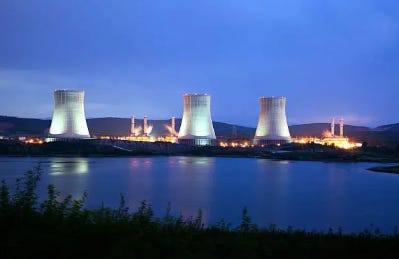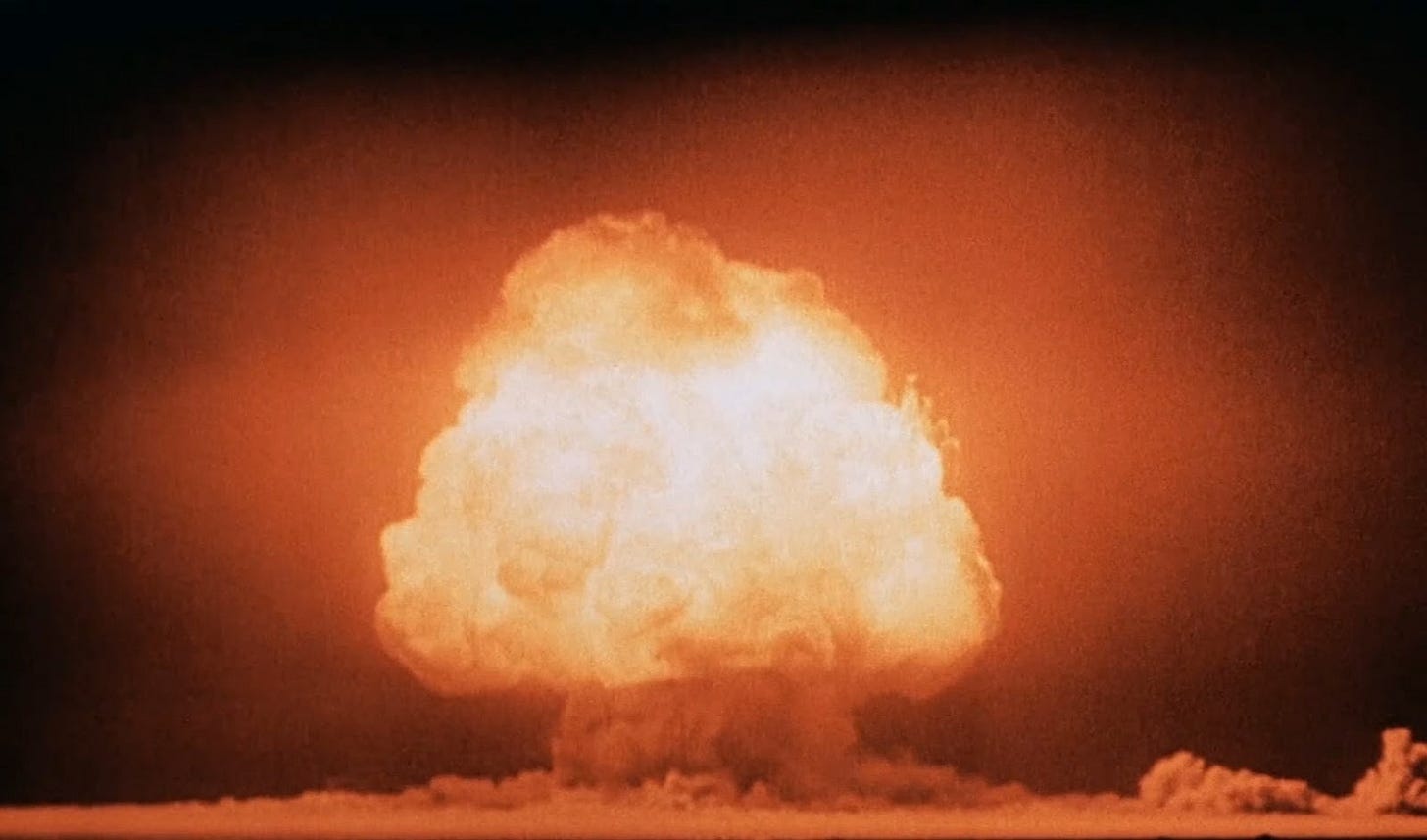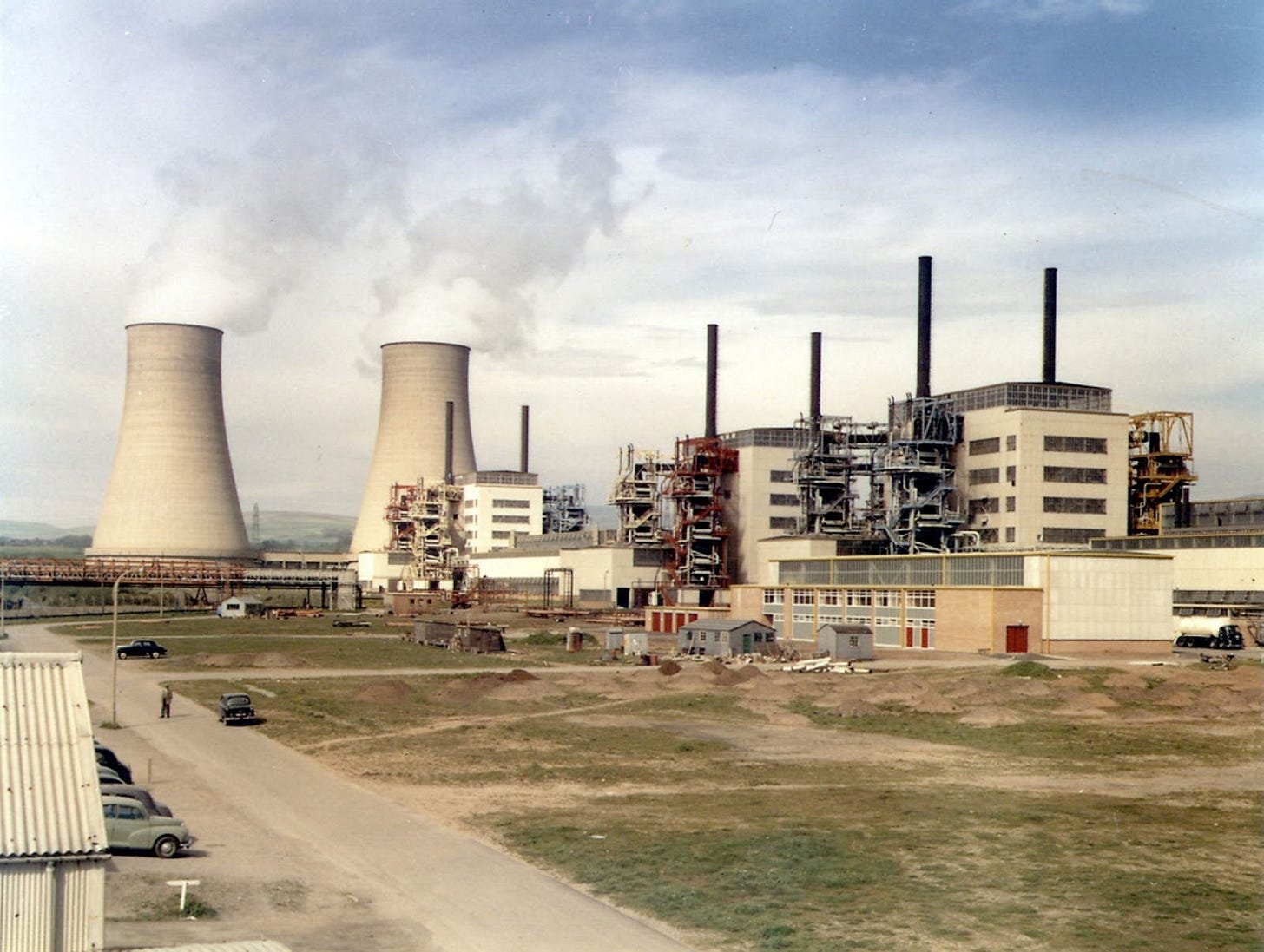Today’s Contemplation: Collapse Cometh CCXIX
We’re Saved! A Nuclear Renaissance Is Upon Us, Part 1.

Energy is the backbone of physical existence. The universe. Our galaxy and solar system. All life on our planet. And of human societies.
As humans discovered means of increasing the flow of energy into our ‘struggle for survival’, our social organisations grew in size and complexity. The transition from small, hunting and gathering bands to small, localised agrarian villages, to large urban centres, to civilisations, and to our present-day global, industrial modernity can be said to be at their base energy transitions.
With respect to modern societies, energy is foundational to all of our sociocultural complexities. And with the growth in size and complexity of these various systems, humans have required evermore energy to support them. Moving far beyond our initial leveraging of fire to supplement natural photosynthetic-derived calories that provided sustenance for our muscles, humans discovered large, one-time caches of stored photosynthetic energy scattered in various forms around the planet–energy that exponentially increased our systems and their complexities.
This massive expansion of the human enterprise fuelled by hydrocarbons provided the opportunity to support more and more individuals and groups engaged in non-food production/acquisition activities. Some of these have focussed their attention upon means to expand further on the types of energy humans can harness/harvest/leverage to support their societal complexities and expansion. In this Contemplation I wish to focus on that provided by the research surrounding the ‘power of the atom’.
Nuclear energy advocates have focused almost exclusively on the benefits that accompany it. Cheap, too cheap to meter in fact. Safe. Improves employment. Reliable. Carbon emissions-free. Efficient. Supports the economy. Secure. Environmentally friendly. Sustainable. Climate fighting. Did I say too cheap to meter?
What’s not to like?
Well…
Nuclear Energy History
In 1896, experimental physicist Henri Becquerel made the first observation of natural radioactivity when he discovered that uranium salts emitted invisible rays that fogged photographic plates. Two years later, Pierre and Marie Curie found two additional radioactive elements (polonium and radium), coined the term ‘radioactivity’, and established that this was an intrinsic property of atoms and not a chemical reaction.
For the next dozen years or so a growing number of physicists focused on uncovering the structure and behaviour of atoms.
Ernest Rutherford’s experiments (1911) led him to suggest an atomic model whereby a tiny, dense, positively charged nucleus was surrounded by orbiting electrons, identifying where immense energy was stored. This model was refined by Niels Bohr (1913) with the help of quantum mechanics that helped to explain how the orbiting electrons remained stable and did not collapse into the nucleus. Bohr’s work was fundamental to later understandings of atomic behaviour.
While the above work was being carried out, Albert Einstein was developing his theory of relativity and published his famous E=mc2 equation (1905) that asserted mass and energy are equivalent and thus interchangeable and, in theory, a tiny amount of mass could be converted into an immense amount of energy. This was a foundational key to explaining the large power source of radioactivity and eventually of nuclear fission.
With this theoretical model in hand, the ‘race to split the atom’ began with the 1930s witnessing a number of crucial developments. Among these was: James Chadwick’s discovery of the neutron (1932); Enrico Fermi’s experiments creating new, artificial radioactive isotopes (1934)–Fermi actually came quite close to achieving nuclear fission when he bombarded uranium with neutrons, but misinterpreted the results; Lise Meitner, Otto Hahn, and Fritz Strassman’s work that found barium in the products after bombarding uranium with neutrons, suggesting that the uranium atom had split (1938); Meitner and Otto Frisch interpreted Hahn’s work as a ‘splitting of atoms’ and called this ‘nuclear fission’–they further calculated, using Einstein’s equation, that an enormous amount of energy had been released via this process; and, finally, Frédéric Joliot-Curie realised that this fission process released additional free neutrons meaning a chain reaction was possible where one fission event could trigger subsequent ones causing energy to be released at an exponential rate.

The above work set the stage for the work of the Manhattan Project. This weapons-focussed project resulted in the first controlled nuclear chain reaction and proved the immense power that nuclear fission could provide. (View the recent movie Oppenheimer for a cinematic recreation of events at this time)
After the American use of two nuclear weapons on the Japanese cities of Nagasaki and Hiroshima (1945), the narrative surrounding nuclear fission for peaceful applications was kicked off by US President Dwight Eisenhower’s ‘Atoms for Peace’ speech (1953) to the United Nations General Assembly. The United States and United Soviet Socialist Republic (USSR) were at the time engaged in a nuclear arms race with multiple tests of increasingly powerful weapons and rising global concern over atomic annihilation. The US had lost its monopoly on nuclear weapons and Eisenhower proposed that the various nuclear-armed nations donate fissionable material to an International Atomic Energy Agency (IAEA) to oversee the material for the peaceful purpose of generating electricity and performing medical, agricultural, and other scientific research.
Eisenhower’s motives, however, were not entirely meant as some beneficent move for the world’s citizens. Yes, it would slow the arms race and divert nuclear fuel away from the weapons programmes. But it was also propaganda to contrast American ‘generosity’ with Soviet ‘secrecy’ and paint nuclear as a benevolent force. More importantly, it was to help set the US up as the global leader in nuclear technology by establishing an international agency that it would control in order to set safety and non-proliferation standards, as well as create a market for American reactors and expertise. The IAEA was established in 1957 and was branded as a ‘nuclear watchdog’ that would promote peaceful technology (and US export of technology and services).
Another shift that occurred shortly after the Second World War and connected to the marketing of nuclear as a peaceful technology was the passing of the 1954 US Atomic Energy Act. This legislation opened the door to private industry owning reactors and having access to classified technical information. The US government maintained control over the fuel but shared its technology with industry and a handful of other nations.
Reactors began to be constructed across the planet with the first plant to generate electricity opening in Obninsk, Russia (1954)–the USSR having developed their own programme independent of the US. The UK opened its first nuclear station (Calder Hall) in 1956, but its primary purpose was to produce weapons-grade plutonium. The Shippingport Atomic Power Station in Pennsylvania was the first in the US to open (1957) and was dedicated solely to electricity generation.

Reactors dedicated to research also proliferated with the US supplying such reactors to dozens of countries.
Optimism regarding nuclear energy and its potential to support and speed human progress grew as quickly as the technology spread. Nuclear-powered transportation. Electricity ‘too cheap to meter’. Nuclear engineering projects. Space exploration and settlement. The future was here and it was nuclear. As a result, the nuclear power industry was catalysed by a couple of decades of global growth in electricity generation and other applications that were easily framed as positive for modernity and guaranteeing infinite human progress. [NOTE: I recall many of the cartoons I watched in the 1960s containing positive aspects of this coming nuclear age (e.g., The Jetsons).]
Global growth in power station construction continued into the 1970s, and was timely given the OPEC oil embargo that resulted in skyrocketing gasoline prices and awareness of dependence upon imported oil. For a growing number of nations, energy security became a national priority and nuclear power plants could provide such an important thing. Massive investments continued to be made as the promise of ‘cheap’ (meterless?) energy and technological optimism spread with stories of continuous improvement and progress being reiterated by the industry, politicians, connected academics, and the media. This time also coincided with the US experiencing its production peak in cheap, conventional oil.
The overoptimism that began with the narrative of ‘Atoms for Peace’ soon collided with the hard realities of economics, safety, and public opinion. The market for nuclear power collapsed almost as quickly as it had risen.
Construction delays coupled with significant cost overruns hampered the idea of imminent power generation that would be too cheap to meter. As safety awareness grew so too did the regulations leading to increasingly complex construction requirements. Price inflation of needed materials during the 1970s exacerbated these cost increases. Plants that were to take a handful of years to construct were taking two to three times longer, resulting in additional price increases as the interest on the loans to fund them compounded. And while the oil shocks served to support their construction, they also triggered a severe recession and era of energy efficiency that resulted in significant electricity demand destruction. Plans for a growing number of power stations were cancelled en masse.
On top of these economic factors were several accidents at plants that shifted public opinion and consequently the political landscape.
The first accident at a nuclear reactor occurred in 1961 at the Idaho National Laboratory when human error resulted in a steam explosion killing several workers and resulting in a meltdown. In 1967, the Pathfinder Nuclear Generating Station in South Dakota was closed permanently (and converted to oil and gas power generation) after only a year of operation (and having spent only 30 minutes at full operating capacity) when a valve was opened too quickly, causing extensive damage. The following year, a reactor aboard a Soviet submarine malfunctioned and emitted gas with fissible material killing 9 crew and injuring 83 others.
In 1979, human error and equipment failure led to a partial meltdown of the US Three Mile Island station. The US Nuclear Regulatory Commission responded by implementing new safety and training regulations thereby increasing costs and construction times for most reactors. For decades afterwards, no new plants were constructed in the US. Only a few years later (1986) a disastrous explosion and fire at Chernobyl’s reactor in Ukraine, USSR, resulted in massive amounts of radiation being released across Europe.
These incidents helped to create an anti-nuclear movement across the globe, but especially in Europe where reactors were phased out or immediately shut down in the wake of Chernobyl.

Concerns regarding radioactive waste were also on the rise. Not only was there no permanent solution to the long-term storage of increasing amounts of radioactive waste, but more and more communities were rallying against both reactors and waste depositories being placed in their regions given the growing awareness of risks.
There was also a concerted movement against one of the more hidden aspects of the nuclear industry’s growth after the war: there was a building proliferation of weapons in a variety of competing nations, especially that of the US and USSR (much under the guise of civilian research). ‘Atoms for Peace’ was being recognised as a narrative management tool in order to distract from the weapons-grade material being produced for militaries. Thousands upon thousands of nuclear missiles had been produced and stored, just in case…
By the 1990s there was little to no growth in the nuclear industry, especially in the West. Not only were no new reactors lined up to be constructed, but the experience of engineers and construction companies was lost. The industry turned to managing its existing fleet of reactors and battling public perceptions. Public trust and political will had been lost.
As the new millennium dawned, there appeared some hope for the nuclear industry given the rising concern of carbon emissions generated by the burning of hydrocarbons. Both the industry and politicians were beginning to once again rest the prospects for humanity’s continued progress on the shoulders of nuclear power generation.
But then came 2011 with the Fukushima accident where a tsunami not only knocked out the grid supplying power to the reactor but backup systems were also made inoperable resulting in radioactive contaminants being leaked into the surrounding environment. One result was that even more countries began to phase out their nuclear energy plants (e.g., Germany).
2020s: A Nuclear Renaissance Is Upon Us…
Almost as if it’s cyclical, many people–from financial institutions to politicians to energy analysts, and even to many environmentalists–have been talking about a nuclear energy resurgence in the last few years whereby greater interest and investment is being directed towards this particular energy production process.
And it is being hyped for a number of reasons: its supposed carbon-free aspect to combat climate change (an assessment that typically completely ignores the massive embodied carbon inputs) and its ability to meet growing demand efficiently, safely, perpetually, and securely, and all while eliminating the need to rely upon hydrocarbon imports. This energy ‘security’ and ‘climate-addressing’ story typically neglects to raise the extremely high ‘costs’ (money and environmental) and lengthy construction times large-scale reactors require.
Enter the recent focus upon small modular reactors (SMRs). This relatively new design is being hailed as less expensive, safer, and more reliable than the traditional large-scale reactors. In particular, the Big Tech corporations have shown interest in order to enable their data centres to draw increasing amounts of power given recent growth. And, as with most new technology, there are only a few operational SMRs with relatively unproven success. In addition, there are concerns about the waste streams, fuel supply, and water requirements of these units–concerns that are being overwhelmed and buried for the most part by the massive marketing/narrative management by nuclear cheerleaders with significant economic interests.
Many nations have jumped on the nuclear power renaissance bandwagon, with more than twenty pledging to increase significantly their use of nuclear reactors–especially SMRs. There have been a number of concerns raised with the fast-tracking that most are promising, particularly surrounding safety oversight and regulatory independence.
China leads the growth of SMR construction and is projected to overtake the U.S. as the leader in nuclear power in the next few years. Estimates for global investment in such technologies is estimated currently at over $2 trillion by 2050 (and will likely be substantially higher given these projects almost always go well over budget). Again, what is left out by most marketers/cheerleaders of these technologies is the potential for much higher electricity costs, limited job benefits, and significant negative environmental impacts
The narrative surrounding nuclear energy has changed over the years. While initially the marketing highlighted the climate change impact such technologies would make (which it never could given the energy output has simply been additive to human energy use), current emphasis–in the wake of geopolitical tensions and supply chain disruptions–is on the energy independence it will provide. This is not to say that the storyline about nuclear addressing climate change concerns has disappeared; in fact, younger generations who have worries about climate have shown great support for nuclear as a ‘clean’ alternative to hydrocarbons.
I will explore in greater detail these SMRs and dive deeper into the negative aspects of this latest and greatest ‘solution’ to our energy predicament in my next Contemplation.
A few recent and relevant articles:
DOE And NRC Sign Addendum To Fast Track Commercial Reactor Licensing | ZeroHedge
Amazon’s Power Shortage Makes The Case For Why AI Needs Nuclear | ZeroHedge
Are Chinese Nuclear Plants Cheaper?
Trump Admin To Lend “Hundreds Of Billions” To Build Nuclear Power Plants | ZeroHedge
Saudi Arabia’s Crown Prince May Provide Boost To US Nuclear Industry | ZeroHedge
State of the Nuclear Renaissance – by Steffan Szumowski
A Giant Problem Emerges For the AI Trade: A Power Shortfall Of 44 Nuclear Power Plants By 2028
The Making of a Too-Big-to-Fail Bubble – by Lau Vegys
What is going to be my standard WARNING/ADVICE going forward and that I have reiterated in various ways before this:
“Only time will tell how this all unfolds but there’s nothing wrong with preparing for the worst by ‘collapsing now to avoid the rush’ and pursuing self-sufficiency. By this I mean removing as many dependencies on the Matrix as is possible and making do, locally. And if one can do this without negative impacts upon our fragile ecosystems or do so while creating more resilient ecosystems, all the better. Building community (maybe even just household) resilience to as high a level as possible seems prudent given the uncertainties of an unpredictable future. There’s no guarantee it will ensure ‘recovery’ after a significant societal stressor/shock but it should increase the probability of it and that, perhaps, is all we can ‘hope’ for from its pursuit.”
If you have arrived here and get something out of my writing, please consider ordering the trilogy of my ‘fictional’ novel series, Olduvai (PDF files; only $9.99 Canadian), via my website or the link below — the ‘profits’ of which help me to keep my internet presence alive and first book available in print (and is available via various online retailers).
Attempting a new payment system as I am contemplating shutting down my site in the future (given the ever-increasing costs to keep it running).
If you are interested in purchasing any of the 3 books individually or the trilogy, please try the link below indicating which book(s) you are purchasing.
Costs (Canadian dollars): Book 1: $2.99
Book 2: $3.89
Book 3: $3.89
Trilogy: $9.99
Feel free to throw in a ‘tip’ on top of the base cost if you wish; perhaps by paying in U.S. dollars instead of Canadian. Every few cents/dollars helps… https://paypal.me/olduvaitrilogy?country.x=CA&locale.x=en_US
If you do not hear from me within 48 hours or you are having trouble with the system, please email me: olduvaitrilogy@gmail.com.
You can also find a variety of resources, particularly my summary notes for a handful of texts, especially William Catton’s Overshoot and Joseph Tainter’s Collapse of Complex Societies: see here.